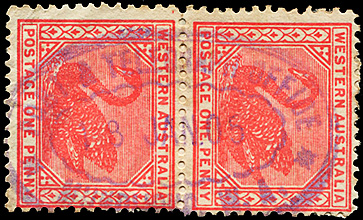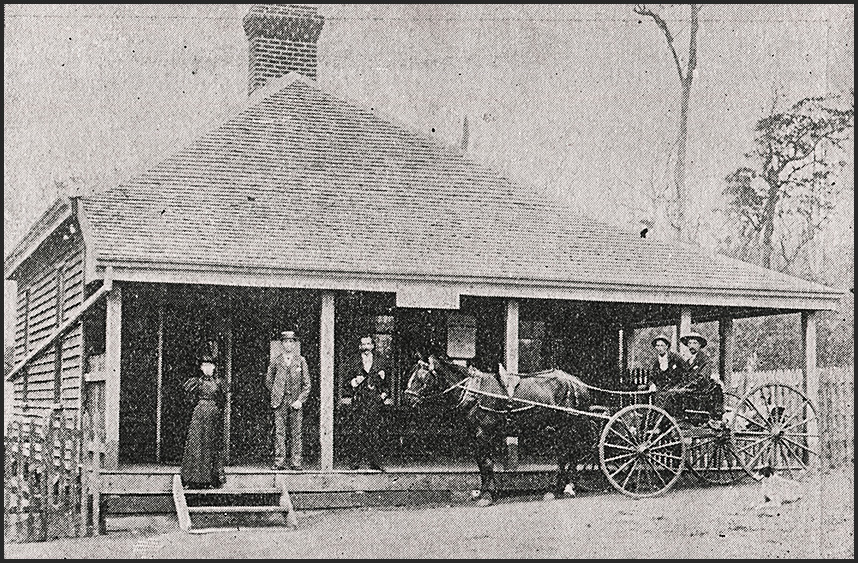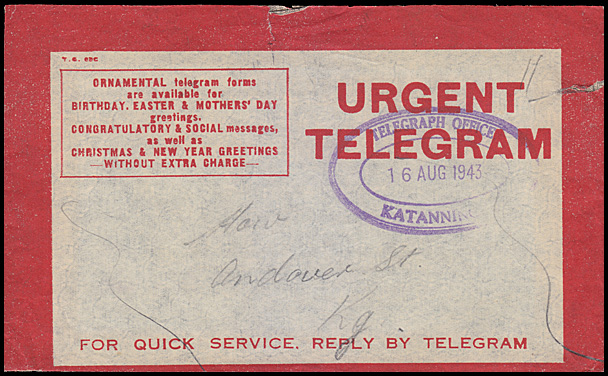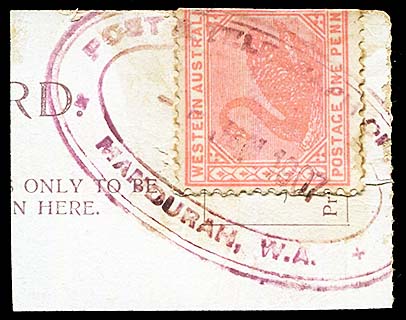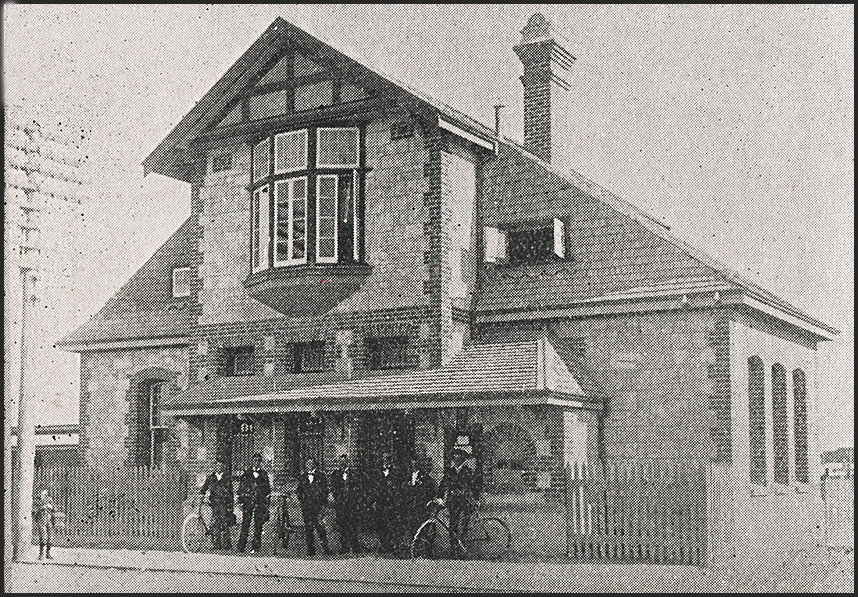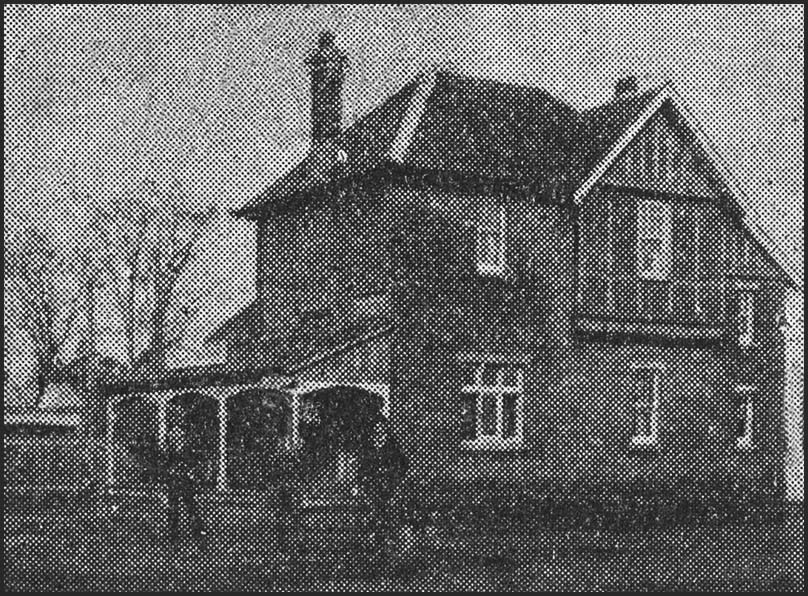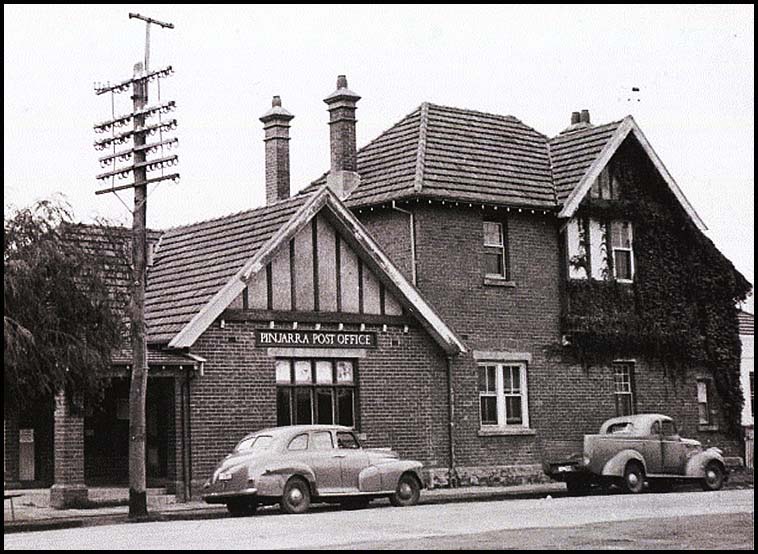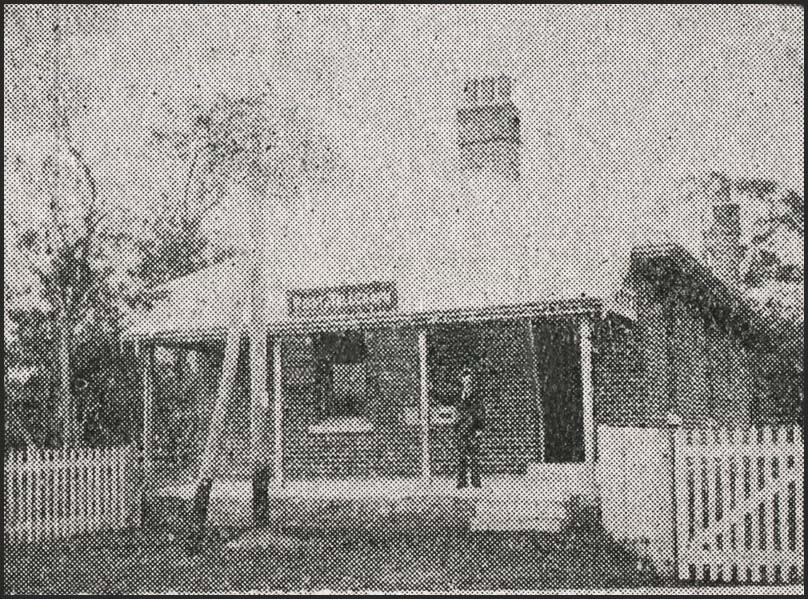Telegraph Offices in the Southern region.
- Australia 1901-1988
- New South Wales
- Overview of NSW
- Telegraph lines
- Telegraph Offices
- Date stamps
- Forms
- Envelopes
- Instructional annotation
- Collect
- Delayed
- Free
- Immediate Urgent
- Reply paid
- Rates
- Stamps
- 1871 Telegraph stamps
- 1885 proposal
- 1893 proposal
- Queensland
- South Australia
- Tasmania
- Victoria
- Western Australia
- International
- Special aspects
The Post & Telegraph Offices on the Southern line are listed in the table below:
The Southern Region of Western Australia is now defined officially as being comprised of three parts - Peel, South-West and Great Southern. Hence Offices as far south as Arthur River are now classified as being in the Wheatbelt region.
The telegraph construction architects and construction workers in the second half of the 19th century did not use these distinctions. The telegraph lines were constructed with the defined purpose of getting communications along the western coast and across to Albany.
Albany was established as an outpost of NSW in 1827 to help combat any territorial ambitions the French may have. It is located on the western side of King George's Sound and the terms became to be used interchangeably to some extent. King George's Sound (from 1805) referred to the harbour while Albany was the settlement on the western shore. It is now King George Sound - because the geographical names people didn't like using possessive apostrophes (') as from the mid-1930s. The Telegraph Office opened in Albany K.G.S., combined with the Post Office, on 22 December 1872. The Albany Post Office had opened on 14 October 1834. Albany had been considered as a possible cable station in the planning of the All-Red route as well as for the cable to Mauritius and Durban. King George's Sound was the first and last port for the English mails (inbound and outbound) as well as for a quarterly shipping service to Singapore. From Albany, the mails were carried by pack horses to Perth in a journey taking about 6½ days. King George's Sound was also the last port for ANZAC troops being taken to Europe and the first Australian port for the few who returned. It was the only deepwater port in Western Australia until 1897 when Fremantle Port was established. About 16 January 1896, quadruplex instruments were fitted and tested in a new telegraph office which was then opened to the public on the following day. |
|
|
|
As aside to the usual problems at the Albany Telegraph Office, the Western Mail of 22 December 1894 reported the following incident: "The train with the colonial mails left Albany for Perth at five o'clock on Sunday afternoon. The notification of this fact was posted at the telegraph office, but back to front, with the blank back of the paper to the public view. A wag, possibly a recent arrival, evidently unfavourably impressed by his first expérience of the colony, had stuck up over the notice paper on a piece of stamp waste the comment, "Symbolical of W.A., a blank fraud." |
| 3. Telegram use.
The earliest recorded telegram form used at Albany is the delivery form WC-DO-4Aa used for a telegram from Perth to Albany on on 13 December 1889. |
|
In 1894, the staff at the Albany Post and Telegraph Office comprised:
It was proposed to increase the operators to 4 to bring the total staff up to 16. 1887+: Alfred N. Piesse was appointed as a Telegraphist after having served at Northam until 1883 and from 1884 at Esperance, Eucla and Israelite Bay. |
| Gouldner (2002) lists no Telegraph date stamps for Albany.
|
||
| 1. The Office was however issued with at least four rubber TELEGRAPH OFFICE date stamps. 1. The first was a rubber oval date stamp (RO6- TO) inscribed TELEGRAPH OFFICE/ALBANY K.G.S.:
|
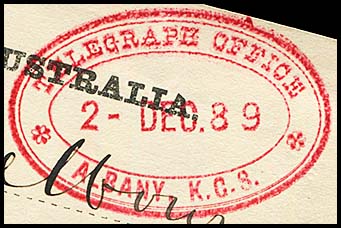 2 December 1889. on WC-TO-3. |
|
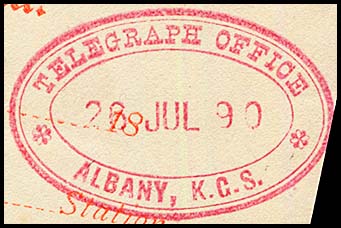 28 July 1890. On WC-DO-4A (with 6d to Collect at Perth). |
||
| 2A. A second rubber oval TELEGRAPH OFFICE date stamp (RO2-TO) was also used. ALBANY was in 3 mm high letters. Has stops after OFFICE and after ALBANY.
|
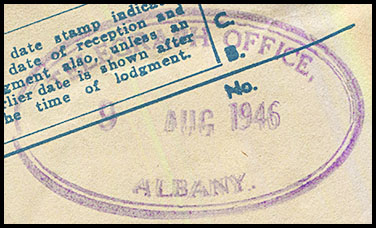 9 August 1946. Used on AW-DO-10 (1944) amd its accompanying delivery envelope (AW-DO-12A). |
|
|
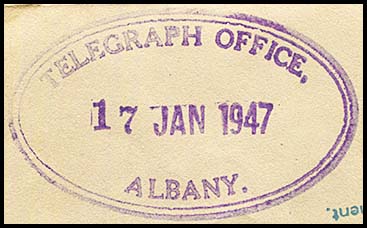 17 January 1947. Used on AW-DO-10 (1944). |
|
2B. A variation of the above second rubber oval TELEGRAPH OFFICE date stamp (RO2-TO) was also used. ALBANY was in 2 mm high letters.
|
|
|
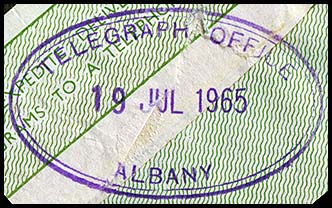 19 July 1965. |
||
| 3. A third rubber oval TELEGRAPH OFFICE date stamp (RO2-TO) was also used. It included "W,A. 6330" at the base and ALBANY was in 3 mm high letters.
|
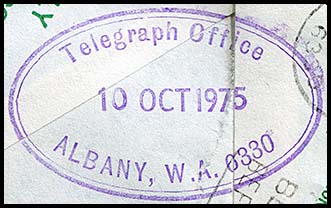 10 October 1975. |
|
4. A fourth TELEGRAPH OFFICE date stamp, having a rectangular shape
(RR1-TO), was also used:
|
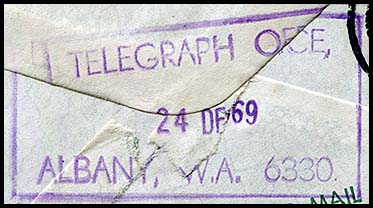 24 December 1969. |
|
The usual postal date stamp - across many variations - was also used on telegrams: Diameter: 25.5 mm. |
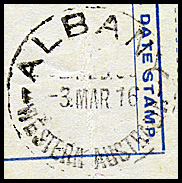 3 March 1916. Used on WI-DI-2A. |
|
|
A Post Office was opened at Blackwood on 1 January 1865. Blackwood was renamed as Balbarrup Post Office in February 1872 and then redesignated as Balbarrup Post & Telegraph Office on 29 February 1896. On 1 January 1903, the Office was downgraded to an Allowance Office. Personnel: John Giblett and his three daughters had been responsible for the postal services to the entire district since the early 1860s (as summarised in a wonderful account by John Stewart for the ABC). The progression of personnel is described in Stewart's wonderful and well researched account. 1896: Miss Pollard was appointed Post & Telegraph Mistress. August 1897: "An ex- telegraph operator named Charles Street was yesterday committed for trial at Bunbury on a charge of having forged the name of Mr. Edward McLarty to a cheque". |
|
The Office was issued with two formats of a rubber oval Post & Telegraph Office date stamp:
|
|
|
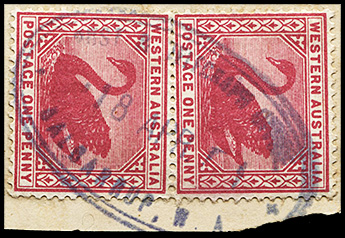 18 April 1901(?). |
|
In November 1897, £650 was allocated in the Estimates for the Post and Telegraph Office. The Telegraph Office at Balingup was opened on 25 March 1899 (according to the report in the Southern Times of 28 March 1899). The Postmistress was Miss F. Giblett. |
|
| No special date stamp is recorded as having been issued to the office for use with Telegraphs. | |
|
Barabup is about 80 km east of Margaret River. "The WA Jarrah Saw Mills Company erected a mill in Barabup in 1908, which was taken over by the Kauri Timber Co. in 1912. In 1913, the company built a vertical log handmill, of the American type, at Ellis Creek - the first of its kind in WA" (see Nannup Town Planning document (c. 2000)). It appears that the previous name had been Barrabup. It was established as an Allowance Office on 1 December 1909 and changed to an Official Office on 15 July 11. About 1915-18, the spelling was changed. For example the Barrabup School was renamed Barabup School in 1918. A Post and Telegraph Office was also opened (date unknown but about 1915) - presumably to service the Saw Mills and some other smaller commercial enterprisesbalbarrup. A steel Barabup date stamp for the Post Office was made under a continued 1907 contract with Cumpston and Mason and issued on 11 January 1916. Perhaps the Post & Telegraph rubber oval was made soon after - it certainly looks to have sharp edges. |
|
A rubber oval Post & Telegraph Office date stamp (RO7-P&TO) was issued to the office:
|
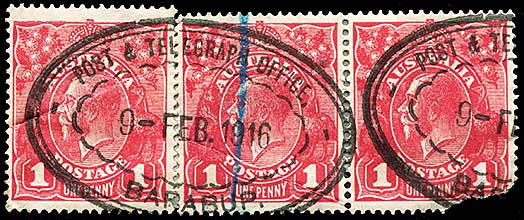 9 February 1916. |
| Mr Chas Bates was Postmaster at Barabup from 1913 to 1922 and was respected far and wide. On his transfer to Dumbelyung, a major festivity was held in honour of Chas and his wife with a special train bringing guests from Ellis Creek and Nannup. | |
|
The West Australian of 2 July 1894 reported "A petition signed by 70 residents of Beaconsfield was forwarded to the Postmaster General a fortnight ago, asking that a Post Office be established in that suburb. The petitioners pointed out that there were over 300 houses in the district, and that the only postal facility enjoyed was a pillar box in Hampton Street which was only cleared at 6 o'clock each morning. There were, however, three or four deliveries. The Postmaster General has replied stating that the establishment of a Post Office at Beaconsfield has been decided upon and he has arranged with Mr.L. J.Stirling, the Postmaster at Fremantle, to select a suitable site for the building. Mr. Stirling will probably report in a few days". A Post & Telegraph Office was opened at Beaconsfield on 1 August 1894. The Western Mail of 4 August reported "A Post and Telegraph office having been opened at Beaconsfield, the principal southern suburb of Fremantle, Mr. E. Solomon, M.L.A. on Wednesday sent the following telegram to the Postmaster -General. "Thanks from people of Beaconsfield for the establishment of Post and Telegraph Office". The Postmaster-General replied: "I congratulate you and the inhabitants of Beaconsfield upon the establishment of a Post and Telegraph Office in your rising suburb and am very pleased to have been able to assist in providing such a long felt want". The people of Beaconsfield who now number over 500 persons, express much satisfaction at the provision of postal and telegraph conveniences in their midst". It changed name to South Fremantle on 1 April 1904. There is no record of a date stamp being issued to the Office for use with Telegraphs. |
| Boyanup.
A postal depot opened at Boyanup as a RMB in January 1895. It was upgraded:
|
|
| Two rubber oval Post & Telegraph Office date stamps were issued to the Boyanup Office. |
| 1. A Post & Telegraph Office (RO2-P&TO). Small crosses for separation are level with the date.
|
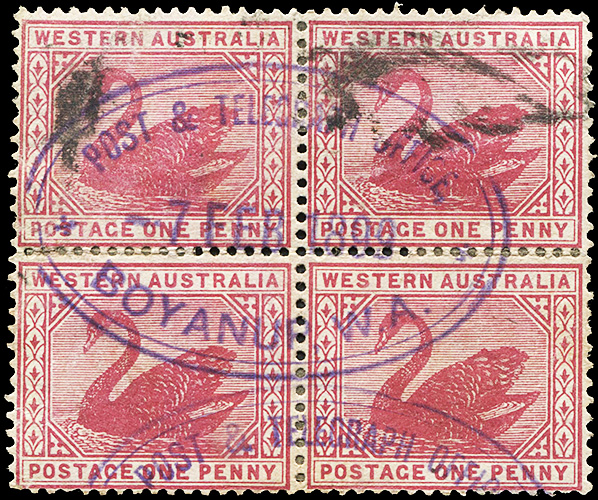 7 February 1899. Used less than 1 month aftre the Office became a Post and Telegraph Office. |
|
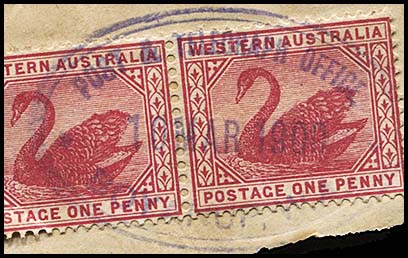 10 March 1900. |
|
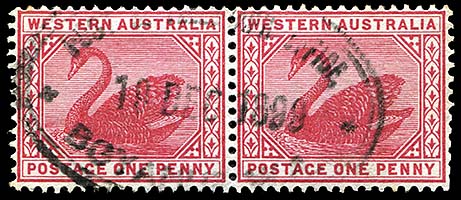 18 December 1899. |
|
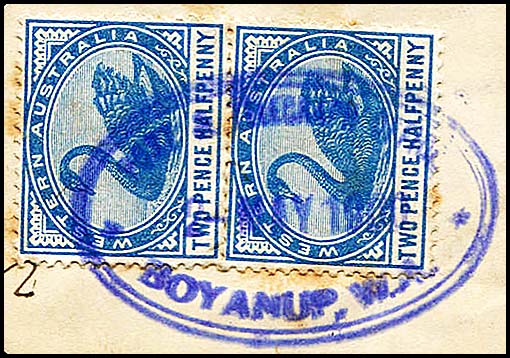 2 May 1916. |
|
Formerly known as Geejelup. A Post Office was opened in February 1872 and upgraded to a Post & Telegraph Office on 30 November 1886. |
|
The Office was issued with four formats of rubber oval Post & Telegraph Office date stamps:
|
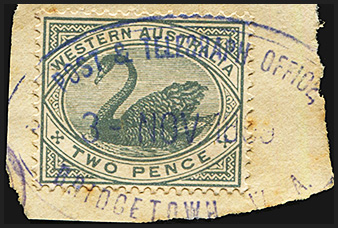 3 November 1899. |
|
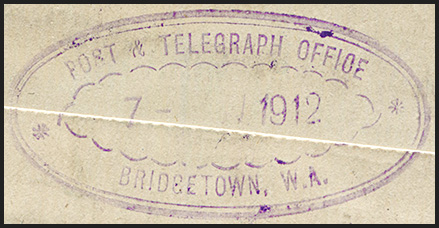 7 [JUN] 1912. |
 11 June 1912. On reverse side of an unclaimed registered letter from the Land Titles Office to Perth and Bulong returned to the Dead Letter Office. |
|
|
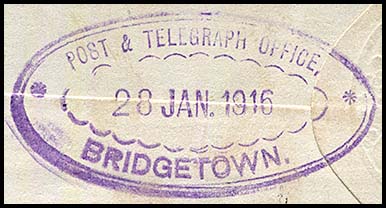 28 January 1916. |
 7 August 1917. |
|
|
|
| Bunbury.
The Post & Telegraph Office opened on 27 February 1872. A Post Office had been established on 15 July 1841. The Evening Times of 2 July 1888 reported: "The villa residence of Mr. E. Woodrow, the Bunbury Postmaster and Telegraph Station master, has now been completed and that gentleman and his family have removed into his new house. The building is one of the best finished houses in Bunbury, the contractors, Messrs. J. and H. Gibbs, having constructed the building with every modern appliance for the convenience of the occupants". In May 1894, it was announced that the lowest tender for the new Post & Telegraph Office had been submitted by Mr. A. Pugh. The new building was supposed to be ready for occupation about the beginning of March 1895 - but the Western Mail of 6 April 1895 reported: "Sir John Forrest, the Premier and member for Bunbury, was on Tuesday informed by telegraph of the opening of the new Bunbury Post Office. Mr. E. M. Clarke, the Mayor of Bunbury, wired on behalf of the inhabitants of Bunbury: "I desire to convey our sincere thanks for the liberal provision made by the Government in the Post Office building here, which we officially used today. We recognise our indebtedness to you personally in this matter. Sir John Forrest replied: "I rejoice with you that Bunbury has been provided with a suitable Post Office and thank you on behalf of the Government for your kind telegram. To me personally this Post Office will always be associated with the generous friendship and support I have all my life received from my old friends at Bunbury and the Southern Districts". The Office used the call signal B. Personnel: December 1875: Mr. Josiah Woodrough was appointed Postmaster and Telegraphis at Bunbury to replace Mr. C. Clifton. September 1882: "Mr. Steere drew attention to the bad condition of the working of the telegraph between Bunbury and Perth. Scarcely a day elapsed when there was not great difficulty in getting a message forwarded. He had asked the Superintendent the reason and had been informed that the junior Telegraph Operator was so deaf that he could not hear He was otherwise a good boy and could perhaps be transferred to some other employment" (Legislative Council, 7 September 1882). July 1888: Mr E. Woodrow (of course). January 1891: Mr. W. Stewart was appointed as Linesman at Bunbury having been transferred from Roebourne where he was Linesman.
September 1895: Mr. T. Roberts, Telegraph Operator was transferred to be in charge of the Coolgardie Telegraph Office. He was succeeded by Mr. Arthur Lee of the Perth Telegraph Department. |
|
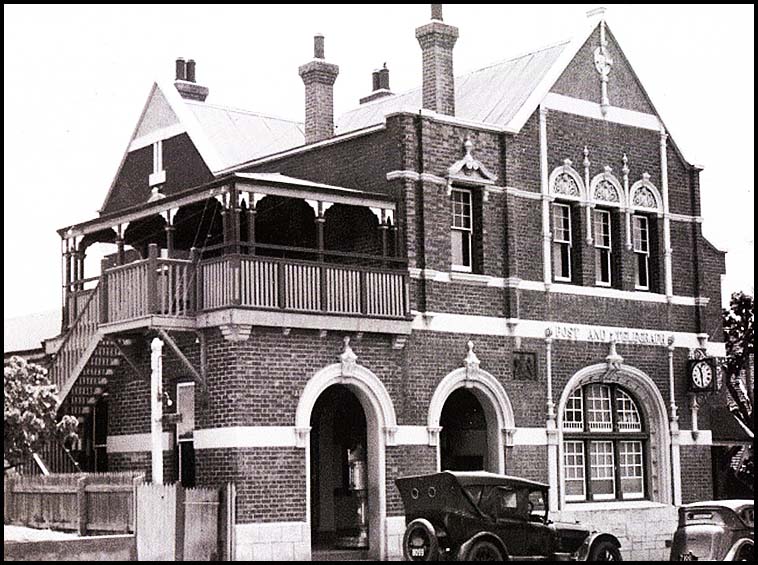 Bunbury Post & Telegraph Office about 1940. |
|
| Four types of rubber oval date stamps were issued to Bunbury for telegram use plus a steel circular date stamp: | |
|
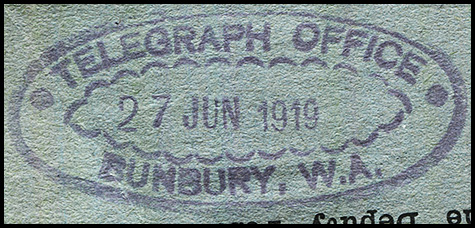 27 June 1919. Used on AE - DO - 1Da. |
|
|
|
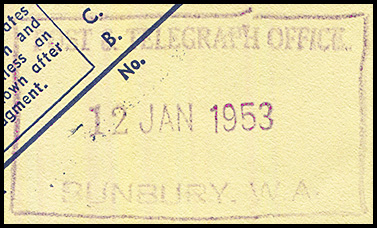 12 January 1953. Showing signs of wear with a break in the top fra,e and distortion to the lowevr frame. |
|
|||
|
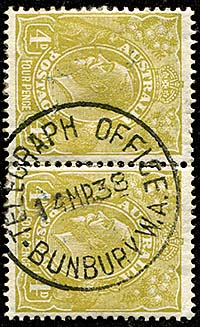 14 March 1938. |
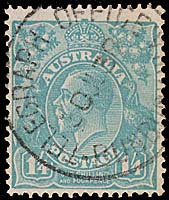 30 July 1938. Used on a 1/4 turquoise KGV - presumably paying the interstate rate which applied between 1920 and October 1938. |
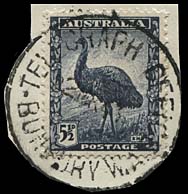 22 March 1943. |
| Busselton (Vasse).
The Post & Telegraph Office opened on 1 January 1893. Another Post and Telegraph Office was completed in April 1896 although it took a short while before they were occupied. Indeed, in November 1897, £2,000 was allocated in the Estimates for the Telegraph Office. As Vasse, it used the call signal V around 1882. |
|
|
|
Personnel:
|
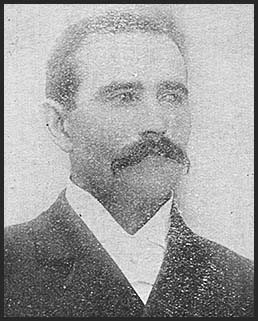 Mr. Pries Postmaster. |
| Four rubber oval Post & Telegraph Office date stamps were issued for use with Telegraphs: | |
|
|
|
|
|
|
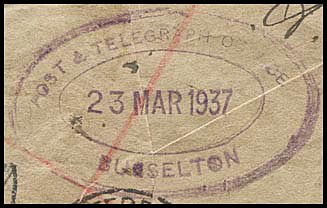 23 March 1937. |
|
|
|
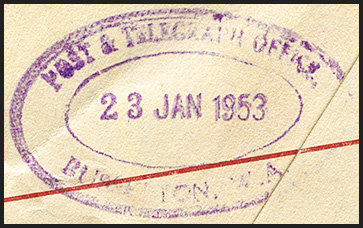 23 January 1953. Applied as a backstamp on a registered letter from Sydney. No damage to the interior oval. |
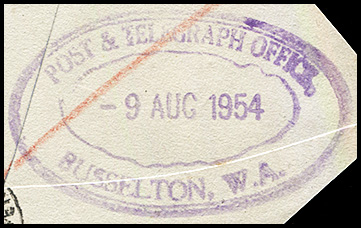 9 August 1954. Damage to interior oval is obvious |
|
|
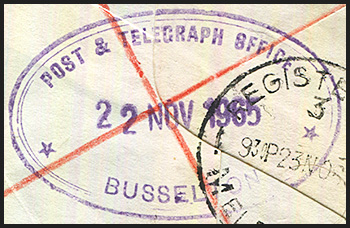 22 November 1965. |
|
The Office replaced Minninup as a Post Office in June 1882. It was then upgraded to a Post & Telegraph Office on 1 December 1897. In November 1897, £400 was allocated in the Estimates for the Telegraph Office. In 1898, the combined office was temporarily renamed Coolingup but it reverted to Capel in 1899. |
|
|
|
A rubber oval POST & TELEGRAPH OFFICE date stamp (RO6-P&TO) was issued to the office named as Coolingup:
|
 May 30 2d grey Swan.jpg) 30 May 189(8?). |
A rubber oval POST & TELEGRAPH OFFICE date stamp (RO6-P&TO) was issued to the office named as Capel:
|
|
|
In 1893, the Government announced that construction of the Lighthouse at Cape Leeuwin was about to begin and that Government labor - not contract labor - would be used. A Telegraph Office was opened in February 1898. |
| No date stamp is know for the Telegraph Office. |
|
A Post & Telegraph Office was established at Coalville on 24 September 1898. It was renamed COLLIEFIELDS early in 1899. |
|
The Office was issued with a rubber oval datestamp (RO2-P&TO) which was used for only 6 weeks - allegedly from 6 December 1898 to 21 January 1899. ACE Auctions (Sale 32 lot 889) show a partial strike for 25 Oc.
|
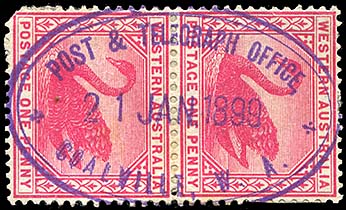 21 January 1899. |
|
The Telegraph Office opened on 1 January 1899 as Colliefields. On 1 January 1900, the namechanged to Collie. Prior to 1899, the Post Office was Coalville. |
. |
Two rubber oval Post & Telegraph Office date stamps were used with telegraph work:
|
|
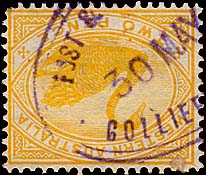 30 May (1899). |
|
|
Collie. The Telegraph Office Colliefields was renamed Collie of 1 January 1900. |
|
Personnel: Those placed in charge of Post and Telegraph Offices had to have a variety of skills as demonstrated by Mr. Bielby, the Postmaster at Collie. The Southern Times reported on 10 January 1911: "With the belated advent of genuine summer, the "snake season" has set in in Collie district: Whilst the capture of no ten footers or rainbow-hued rattlers, hooded cobras, or baby boa-constricators has yet been reported (and it is that surely that such will be, the spirited detailed hereabouts being of the purist), the intrusion of one black reptile is of the "Dugite" species, into the privacy of a dwelling occur red on the night of Friday 6th inst. Mr A. H. Beilby, the Collie PostMaster, seated writing at his dining room table, heard a sound suggestive (to his Nor' West experienced ears) of the progress of a snake. Glancing down Mr. Beilby observed a black reptile disappear under a sideboard. Procuring a Commonwealth departmental spade,and standing on no Red Tape ceremony, the Postmaster pulled the sideboard out and playfully dug His Snakeship in the small of his back. The dig made the Dugite a "deader" and, upon being taped, he measured 2 feet and 9 inches. Mr Beilby's happy family of young Australians were fortunately absent from home at the time of the intrusion of the snake which was considered to be of the venomous species". |
| Cookernup.
A Post & Telegraph Office was opened at Cookernup on 20 June 1897. |
|
|
|
Three formats of rubber oval Post & Telegraph date stamps were issued to the Office:
|
|
|
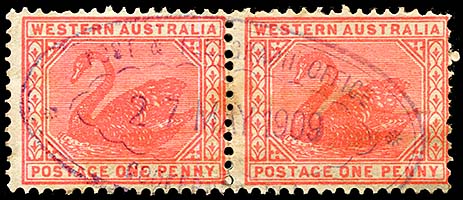 27 May 1909. |
The third strike was offered by Phoenix Auctions in February 2024. It also is on a 1d red Roo and is about 60%. The strike has "5" showing for the day - but it could have been "15" or "25" May. |
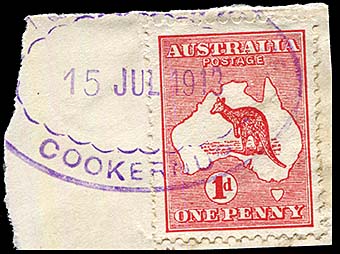 15 July 1913. |
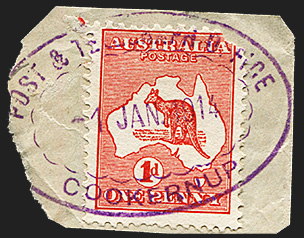 1 January 1914. |
|
|
The Telegraph Office was opened on 23 September 1929 but no record is available to show when it closed. |
|
Strike made in favour.
|
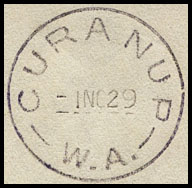 1 November 1929. |
|
A Post and Telegraph Office was opened at Dardanup on 11 October 1895. The building was completed during October and taken over by the Telegraph Department. The Southern Times of 10 January 1911 noted "A public meeting was held at Dardanup last Saturday. The Chairman (Mr. Eph. Gardiner, J P.) said that 15 years ago, there was a Telegraph Office at Dardanup. Dardanup was going ahead and the Department's action appeared unexplainable. He suggested a petition being drawn up against the removal of the Telegraph Office. Mr. R. S. Palmer stated that he did not think the telegraph would be installed again as the number of messages sent there only averaged four daily. So long as the wires were kept private, and he thought a good telephone cabinet would ensure this, it really did not matter how the wires were sent. The Chairman: It's a question of taking away what belongs to us. Mr. G. A. Fee seconded the Chairman's suggestion of a petition against the removal of the telegraph, which was carried". Personnel: October 1895: Mrs. Cumming was appointed as the first Post and Telegraph Mistress. April 1897: Miss M. Pollard was appointed Post and Telegraph Mistress. |
At least by the beginning of 1900s,the Office was issued with a rubber oval Post & Telegraph Office date stamp (RO7 - P&TO). Given the signature on the piece below and the clean lines of the strike, this might have been the first use of a new date stamp.
|
|
The Office was later issued with a rubber oval Telegraph Office date stamp (RO6-TO).
|
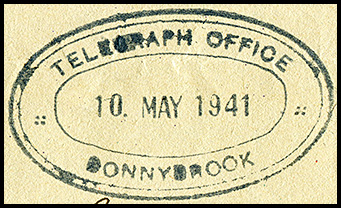 10 May 1941. Used on AB-GMF-34. |
The Office was later issued with a rubber oval Post & Telegraph Office date stamp (RO6-P&TO):
|
| East Fremantle.
The Telegraph Office opened on 1 January 1899 when it changed name from Plympton. The former office had opened as a Post & Telegraph Office on 14 March 1898. |
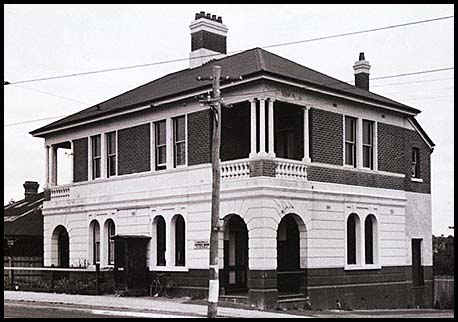 East Fremantle Post & Telegraph Office about 1940. |
| Three formats of rubber oval date stamps issued for telegraph purposes are recorded: | |
|
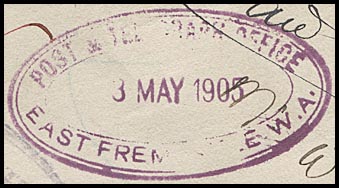 3 May 1905. |
|
Used on AW-DO-10D (43). |
|
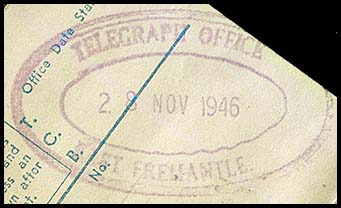 28 November 1946. Used on AW-DO-10 (46). |
|
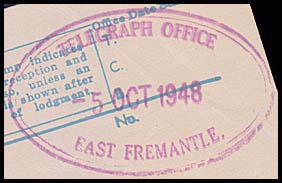 5 October 1948. Used on AW-DO-10D (43). |
Fremantle.
The Post Office had been opened on 9 May 1830 in a general store operated by Mr. Alex Francisco Snr who therefore also acted as the Postmaster. The store was on Mouatt Street opposite the (then) location of the W.A. Bank. Another store also opened at the same site - Reichlberg & Co's Meat and Fish Preserving Establishment. A Post Office building was opened in Henry Street in a small vine-clad cottage. The address and date of every letter sent was recorded. The Office then moved to High Street before moving again to the Commissariat Buildigs in Cliff Street. A final move was to a new building on the corner of Cliff and Cooke Streets. |
|
The Fremantle Telegraph Office was opened at 3:00 pm on 21 June 1869 on the completion of the construction for the first telegraph line in Western Australia by the private company the West Australian Telegraph Company. The Resident Magistrate in his message sent to Perth indicated that the incoming message "has been received at the Court-House". So no special structure had been constructed. Indeed the first message was received by William Holman in an old shed at the back of Kett's woodyard in High Street. Soon after, a small cottage in High Street became the first actual Office for the telegraph. It used the call signal FR. |
In less than two months, suggestions were being discussed for the installation of a time-ball at the Town-Hall connected with Perth via the new telegraph line. On 8 July 1870, the Express reported "It is proposed, we believe, to remove the Telegraph Office in this town to a more convenient situation. The present office is a damp and dingy looking place, and the approach to it is so muddy this wet weather, that persons who have occasion to go there, if their boots have been newly polished, are obliged to walk 'circumspectly ". The situation was described further by the Fremantle Herald a month later on 13 August: "Where is the new Telegraph office to be? That it can much longer continue in its present vicinity is, of course, impossible. We have heard all kinds of localities suggested as the most appropriate and eligible site for a new office. The present dark, damp and crazy tenement is not only an anachronism, even in this anti-progressive colony, but is positively becoming a nuisance. The approach to it is filthy and disgraceful, and the result of the recent heavy downfalls of rain is such that the floor of the dingy hovel wherefrom messages are transmitted is flooded with water or, more properly speaking, a foul admixture of that element and the filth and mud discharged from the contiguous stables. We have been again asked to call the attention of the Company to the existing state of things, and we hope that some early and improved arrangement will be made by them for affording superior accommodation for their customers". |
|
The earliest recorded telegram usages at Fremantle are:
|
|
December 1868: Mr. Alexander Francisco jnr was appointed Postmaster at Fremantle to replace Mr. A Francisco senior who had resigned. June 1869: Mr. William Holman was appointed the first Operator at Fremantle. He had formerly been a seafaring man on board the barque Zephyr which traded between Fremantle and London. Mr. W. T. John was the first messenger at Fremantle. End of 1869/beginning of 1870: Mr Horrace George Stirling (born August 1855) replaced Mr. Holman as Telegraph Manager/Operator - at the age of 14. ?? Mr. Lewis James Stirling (born Sept 1857) replaced his brother Horrace as Telegraph Master. He was later transferred to York. January 1891: Mr. W. McMullan and Mr. R. Counsel were appointed as Telegraph Messengers. In 1894, the staff at the Fremantle Post and Telegraph Office comprised:
It is proposed to increase the staff by:
May 1894: Mr. E. Watson was appointed as Telegraph Operator. 1895: Mr. Lewis Stirling (son of Edmund Stirling) was the Postmaster at Fremantle having previously been at Victoria Plains enroute to Champion Bay (Geraldton). August 1896: Mr. R. Rosling was appointed Senior Telegraph Cadet. |
|
A number of date stamps were produced for use at Fremantle in conjunction with telegraphic matters in either rubber or steel. Goulder lists six oval date stamps which included the word TELEGRAPH as having been issued for use with telegrams at Fremantle. In addition there was one (RO4-P&TO) for Fremantle Railway Station. |
| RUBBER oval date stamps: |
|
|
|
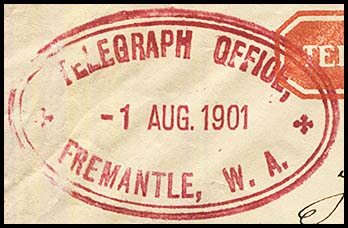 1 August 1901. Used on WC-EO-3. |
|
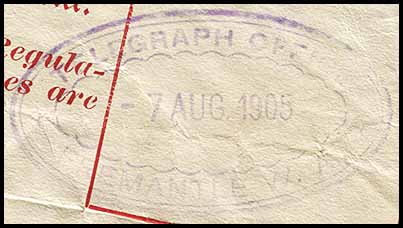 7 August 1905. Used on WI-DO-1A. |
 25 August 1905. Used on WI-DO-1A. |
|
| An example is also known in blue but measurements to confirm its classification are not available. The strike was also on the flap of W.A. delivery envelope WC-DO-4. Details of the image can be obtained from Abacus Auctions Sale 254 of December 2023 Lot 3393. | |
|
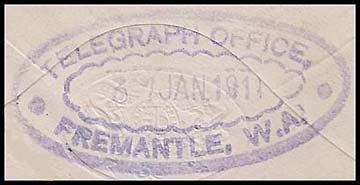 31 January 1911. Used on WC-EO-4 to London as a backstamp. |
|
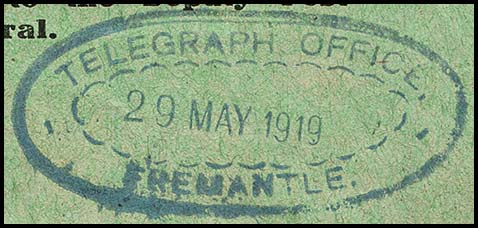 29 May 1919. Used on AE-DO-1B - a rare form sent to HMAS AUSTRALIA. |
|
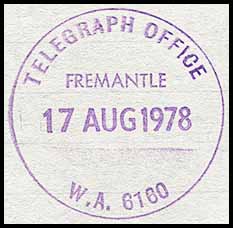 17 August 1978. |
|
|
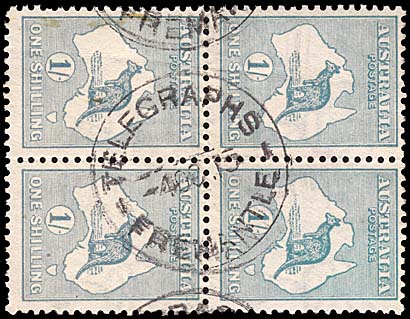 4 October 1915. |
||
Different format. Letters (especially the G and R) are differebt shapes. Separation dots not arcs. |
 30 September 1919. On AE-DO-1B. (Abacus 7 April 2019; Lot 1398). |
||
|
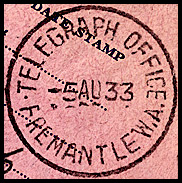 5 August 1933. Used on AB-DU-6. |
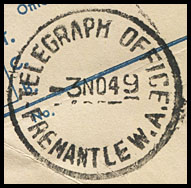 3 November 1949. Used on AW-DO-10B (47). |
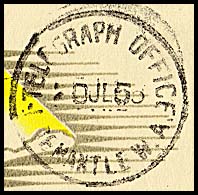 20 July 1955. Used on AW-GSF-54C. |
| The usual postal date stamps were also used on telegrams. | 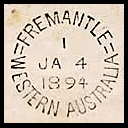 Unframed FREMANTLE/WESTERN AUSTRALIA. 4 January 1894. |
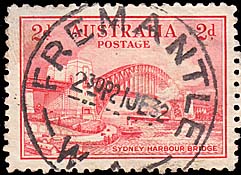 Fremantle. 21 June 1932. |
|
|
The townsite was first gazetted in 1908 under the spelling of Ngowangerupp and an Allowance Office opened on 9 May 1910. The local people were however dissatisfied with the spelling of their town so consequently - in 1913 - the name was altered to Gnowangerup. Hence the status of the Allowance Office was upgraded to that of an Official Office - encompassing the Post and Telegraph Office - on 25 June 1913. |
|
The Office was issued with a rubber oval Post & Telegraph Office date stamp (RO7-P&T) for use with telegraphs.
|
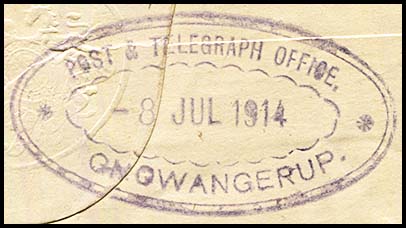 8 July 1914. Used on a registered OHMS envelope sent from Perth to Broomehill then redirected to Gnowangerup and then retuened to the Land Titles Office. |
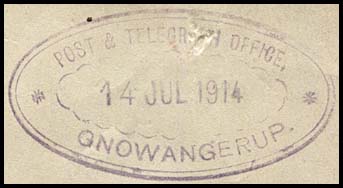 14 July 1914 |
|
| Greenbushes.
In the Legislative Assembly on 29 February 1891, £100 was allocated for a Postmaster and Telegraphist at Greenbushes. On 16 April 1891: Tenders were accepted to supply furniture for the Telegraph Office, Greenbushes: £15." Finally, in the Southern Times of 20 April 1891: "The long wanted Post and Telegraph Office will soon be a reality as the building for the purpose will soon be completed and, when opened, it will be a great boon to the place". The Post & Telegraph Office opened on 5 May 1891. |
|
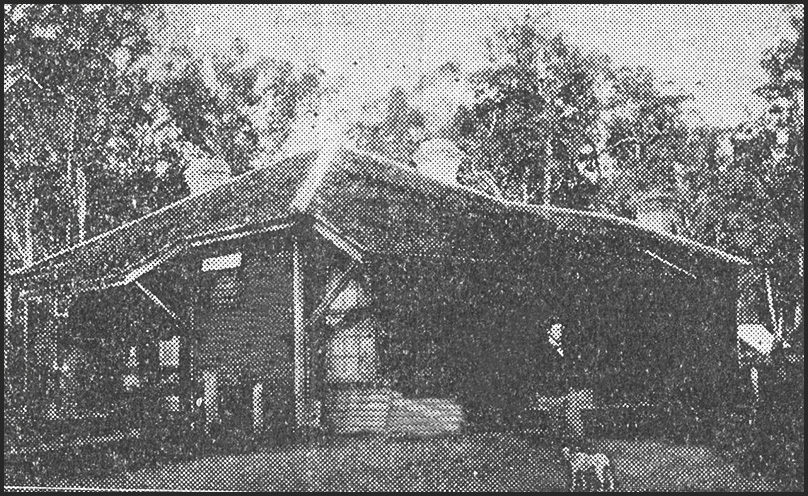 Greenbushes Post and Telegraph Office in mid 1890s. Scanned from Souvenir of the Postal, Telegraphic and Telephone Departments of Western Australia, GPO Perth Christmas 1898. |
|
Greenbushes was a major centre for tin mining. The Southern Times of 25 August 1890 reported: "A movement is on foot to obtain a Post and Telegraph Office at the Greenbushes Tin Mines. This is an urgent want to which we have repeatedly called attention and, as the telegraph line to Yilgarn is virtually adopted, we apprehend the Government will hardly refuse the trifling outlay necessary to open an office to enable the public there to utilize the line now existing and which passes through the field. Two memorials are at the stores and are being numerously signed. It is understood that the use of a building could be obtained gratis or for a nominal sum as attached to some of the existing buildings. In view of the abundance of timber on the ground, it would perhaps be advisable for the Government to build an office in a central position where the townsite will eventually have to be, That course that would be cheaper in the end if the mines are going to last as long and with as good results as experts predict". |
|
August 1893: Mr. C. B. Teede was appointed as Post and Telegraph Master. May 1891, J. Horrigan was promoted to the position of the first Postmaster and Telegraphist at Greenbushes from his duties at Guilford. 1898: Mr. H. Wansborough was Post and Telegraph Master. |
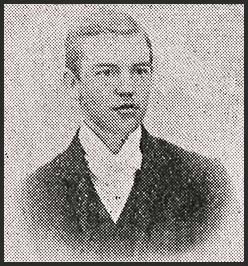 Mr. H. Wansborough. Post and Telegraph Master about 1896. Scanned from Souvenir of the Postal, Telegraphic and Telephone Departments of Western Australia, GPO Perth Christmas 1898. |
| Three special date stamps were issued to Greenbushes for use with telegrams: | |
|
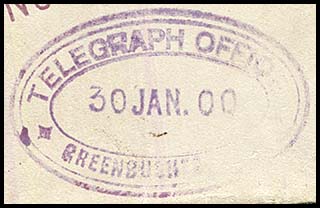 30 January 1900. |
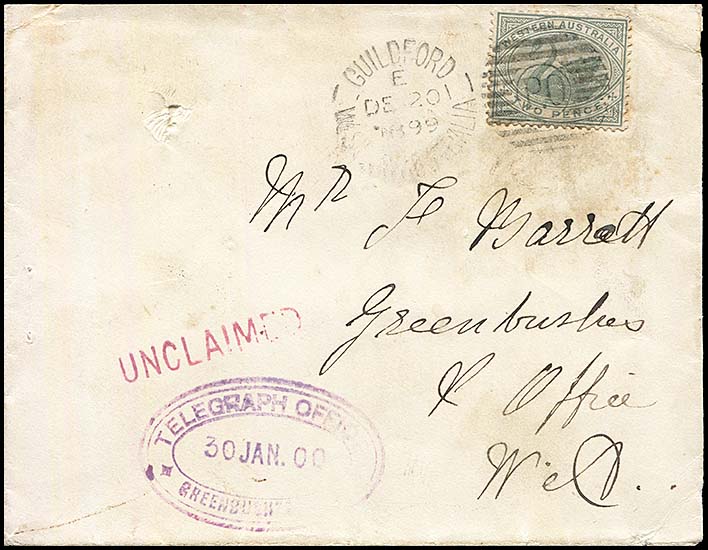 30 January 1900 - cover showing oval date stamp. |
|
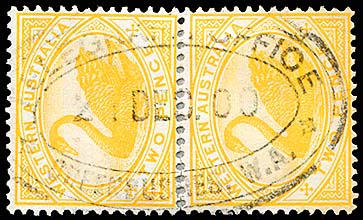 21 December 1900. |
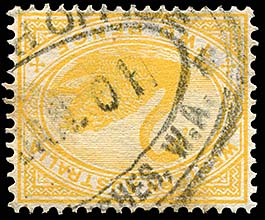 January 1901. |
|
Used on the flap of a delivery envelope AW-EO-16Ba. |
|
|
| Jarrahdale.
The Telegraph Office opened on 11 February 1880 and the Post and Telegraph Office had been taken over in August 1882. This information was provided in the Legislative Council on 1 August with the explanation that the action had involved the expenditure of £68 as against the receipts from the postal department being valued at £200 per annum and the telegraph department alone realising £90. On 20 March 1896, the Western Mail reported that "Our new post office is nearing completion, and is a very creditable looking building. It is a great improvement on the hut which has done duty so long as a post and telegraph office". Jarrahdale used the call signal I around 1882. |
|
|
|
POSTAL AND TELEGRAPH ARRANGEMENTS AT JARRAHDALE. SIR,— The telegraph and postal arrangements at Jarrahdale are the most extraordinary that could well be imagined. There is no delivery by post-boy of letters or telegrams arriving at Jarrahdale and therefore, to make sure your correspondence is not returned to the dead letter office, it is necessary that you should on the arrival of each mail enquire if any missive has been sent to you ; failing this, letters and telegrams have been known to be so delayed as to frustrate the object for which they were sent. I myself, during a recent visit to Jarrahdale, suffered considerable inconvenience and loss of business owing to a telegram having been detained at the office after its arrival for fully three hours and a half and, on complaining to the Post Mistress, I was told neither letters nor telegrams were delivered because the authorities would not provide a messenger. Yet on referring to clause 6 of the conditions under which messages are transmitted I find the following — "Every reasonable exertion is used to secure the greatest promptness, accuracy and dispatch in conducting the business of the Telegraph;" and, under "scale of charges", the public are further informed that messages are delivered free of charge within a mile of the office." In my case, my telegram, although I lived only 50 yards away, was so delayed — I having received it after the office was closed on Saturday evening — that I had no opportunity of replying to it for forty-four hours. I am not a litigious man, but I certainly think I have cause of action against the Government and I trust, having made out my case so far, that some steps will be taken by the proper authorities to remedy the defects I have drawn attention to as quickly as possible. Yours, etc.,TRAVELLER(Daily News 7 March 1890). |
|
Personnel: 1881: Mr. John Stokes was the Telegraph Operator. January 1891: Mr. C. B. Teede was appointed as Telegraph Messenger at Jarrahdale. February 1895: Mrs kiernan was apponted Post Mistress, August 1896: Mr. E. S. Watts was appointed Assistant Telegraph Operator. April 1897: Miss. M. A. Troy was appointed as Post-Mistress. |
|
| The Office was issued with two oval date stamps for use with Telegraphs - both previously unrecorded: | |
|
|
|
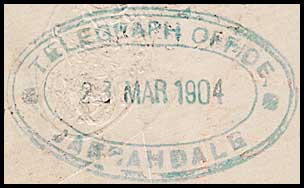 23 March 1904. |
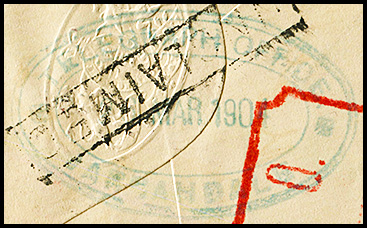 30 March 1904 - see below. |
|
|
|
|
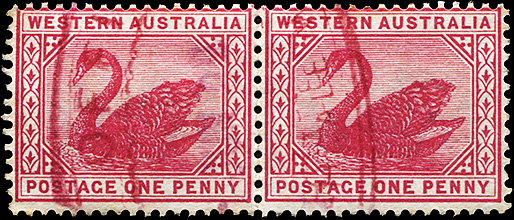 |
|
A Post & Telegraph Office was opened at Karridale on 11 April 1893. An Operator had left Bunbury on 9 April 1893 on the S.S. Albany to open the Karridale Telegraph Office. The township which existed at that stage, was destroyed by bushfires in 1961 and a new township was was subsequently built a little to the north-east. A postmark from a temporary Post Office carried the inscription "destroyed in fire 1961". |
|
|
|
Personnel: Mr. G. H. Percival was appointed Post and Telegraph Master in 1898 (?) |
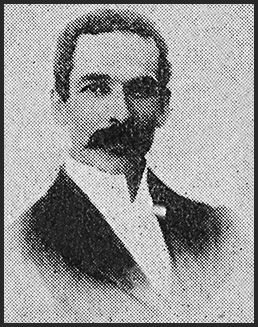 Mr. G. H. Percival. Post and Telegraph Master. Scanned from Souvenir of the Postal, Telegraphic and Telephone Departments of Western Australia, GPO Perth Christmas 1898. |
| No special telegraph date stamp is known for Karridale. | |
|
The first Post Office opened as Moojebupin in January 1881. It was renamed Katanning Post Office on 1 July 1889 with Mr. Charles Austin Piesse as the first Postmaster. |
|
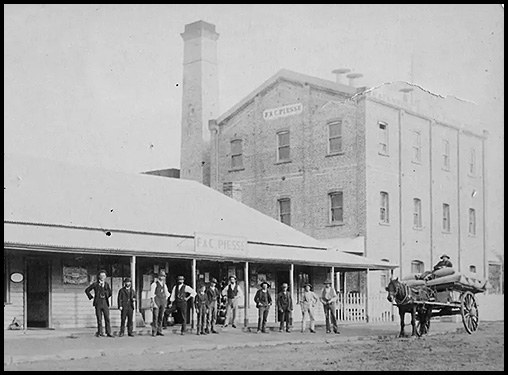 See Katanning Historical Society (lostkatanning.com). |
In 1891, the older brother - Frederick Henry Piesse - built the Katanning Flour Mill and a larger store in partnership with Charles. The National Bank of Australia Ltd used part of the store as did the first Post Office in Katanning. As there was room, the store was also apparently also used as a Court House and as a church according to demand.
Thankfully there are some people who value history and work to protect it. In 2018, Jane and Michael Pelusey bought the old flour mill - allegedly for $1 - and turned it (with lots more $$$s) into the magnificent Premier Mill Hotel. |
In October 1892, a tender was accepted from Mr. Wm. Trott for the Katanning Post and Telegraph Office and quarters for £ 986 17s. The Post & Telegraph Office was opened on 4 August 1893. A congratulatory telegram was sent by Mr. A. W. Piesse and W. K. Adam to the Premier (John Forrest) who replied "I thank you for your congratulations on the establishment of telegraphic communication with Katanning and the other rising townships on the Great Southern Railway. I sincerely hope that your town and district will continue to progress, and you may be assured of my continual desire to promote your best interests in every possible way". |
|
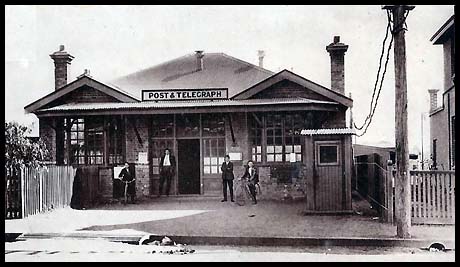 Katanning Post & Telegraph Office about 1910. |
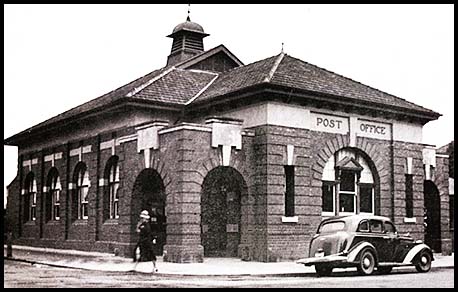 Katanning Post & Telegraph Office about 1940. |
Personnel: January 1893: Mr. A. W. Piesse was transferred from the Williams River to take up the new position of Postmaster and Telegraph Master at Katanning. Pending the handing over of the new Post Office, the business was being carried on in one of the anterooms of the Hall. "Mr. Piesse is one of the oldest telegraph operators in the colony and has had upwards of twenty years experience in the postal department, so that the people of the town and district may fairly congratulate themselves on an appointment by which they cannot but receive material benefits. With the inception of official responsibility will come a money order office, a great convenience for the transmission of small sums, and a Savings Bank, the advantages of which need no demonstration. The telegraph line will also be an immense boon to the town generally and, it may fairly be prophesied, the business transacted in every branch of the office will warrant the expense of its erection. For a considerable period the mails were in the hands of Mr. Arnold Edmund Piesse, who conducted the business efficiently and well and, more recently, Mr. Sydney E. Ing, who also attends to the clocks of the district, had charge of the Post Office, to the satisfaction of the public generally and to his own credit" (West Australian 16 January 1893). December 1906: Mr. John Gerrans, Post and Telegraph Master at Kookynie, was transferred to Katanning. |
|
| Katanning was issued with three date stamps for use with Telegraphs: | |
|
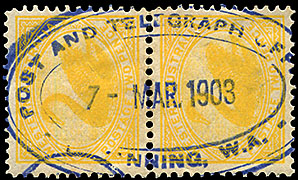 7 March 1903. |
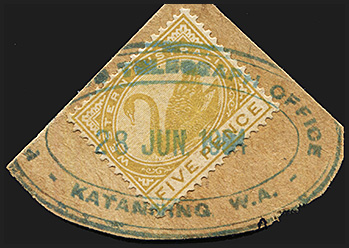 28 June 1904. |
|
|
|
|
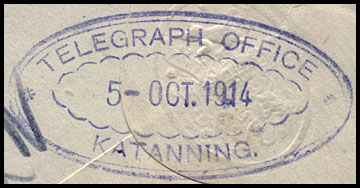 5 October 1914. |
|
|
| Kojonup.
A Post & Telegraph Office was opened on the first line to Albury on 22 May 1875. The Telegraph Office was probably used as a repeater station. The first designated Post and Telegraph Office building was constructed in 1897 in Spring Street. A second building was constructed in 1913 on the Albany Highway before being re-used as the Headmaster's House and, more recently, as the Headquarters of the Kojonup Historical Society. A Post Office had been opened on 18 October 1864 under the supervision of Sgt. Loton. |
|
The office was issued with a rubber oval POST & TELEGRAPH OFFICE date stamp (RO7-P&TO).
|
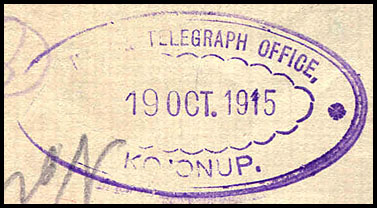 19 October 1915. Premier Auctions, May 2016. |
|
An Administrative Office was opened at Margaret River in February 1913.
|
|
|
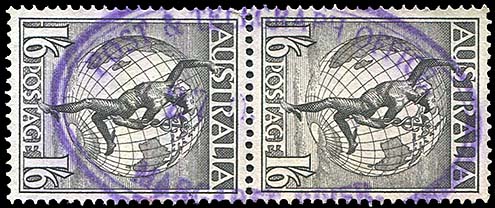 27 October 19?? (on 1949 1/6 Hermes pair - issued 1 September). |
|
A Post Office was opened on 1 April 1846. This Office was closed and replaced by Serpentine on 20 November 1858. The Mandurah Office reopened on 1 January 1865 and was upgraded to a Post & Telegraph Office on 22 December 1886. |
|
| The Office was issued with three formats of rubber oval POST & TELEGRAPH OFFICE date stamps: | |
|
|
|
|
|
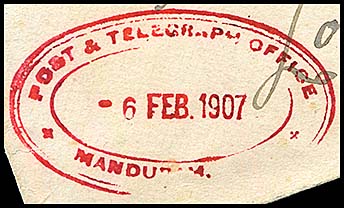 6 February 1907 - detail of oval from cover below. |
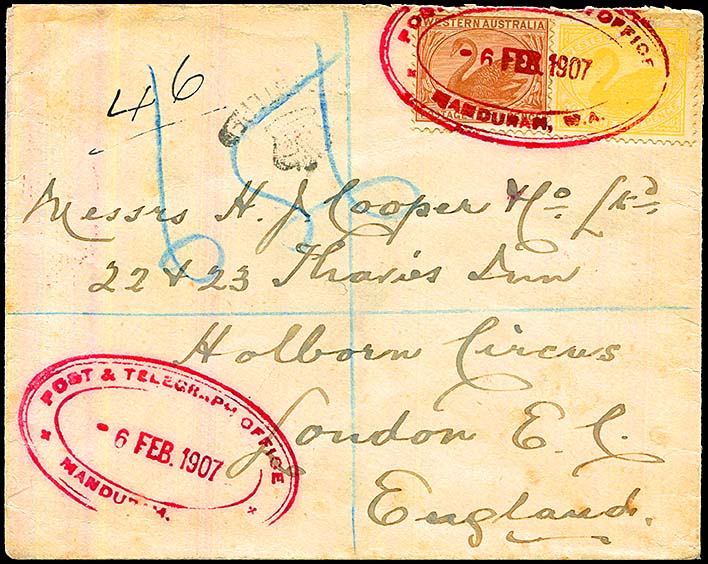 Cover from Mandurah to England 6 February 1907 with two strikes of the Mandurah oval RO6 - P&TO. |
|
|
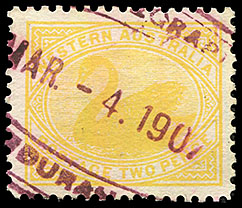 4 March 1907. |
|
|
|
In 1910, the railway was being extended from Bridgetown to Manjimup although work was not completed until about mid 1911. Possibly the telegraph would therefore be made available at the Railway Station. Had a P&TO Office before 1913 but using primtive organisation. Post-World War 1, Manjumup became part of the Group Settlement Scheme which was unsuccessful. Today Manjimup not only produces timber but it is the home of Pink Lady apple production, of green tea and of truffle production. |
|
Date stamps. An oval rubber POST & TELEGRAPH OFFICE (RO7-P&TO) date stamp was issued to the Office in two slightly different sizes: |
|
Used: 30 September 1963.
|
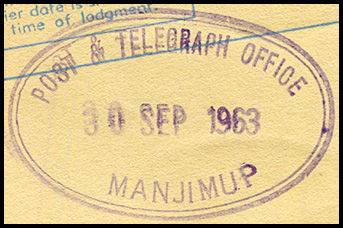 30 September 1963. Used on delivery form AW - DO - 10 (1960). An 80% strike also appears on the Wattle delivery envelope (AA-GGE-2) above the window (missing Manjimup). Image kindly supplied by Malcolm Brown W.A. |
Used: 11 July 1964. |
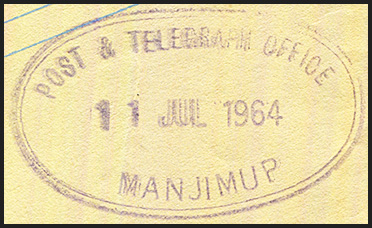 11 July 1964. Used on delivery form AW - DO - 10 (1960). |
|
A Post & Telegraph Office was opened on 7 May 1900. It was the site of considerable timber gathering activity located on the Darling Range.
The Office was issued with at least two formats for rubber oval Post & Telegraph date stamps. |
||
|
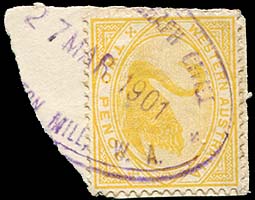 27 March 1901. |
|
|
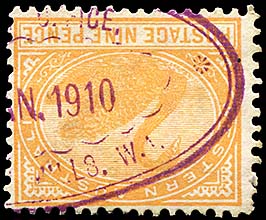 J(?)an 1910. |
|
|
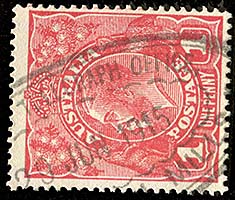 29 June 1915. |
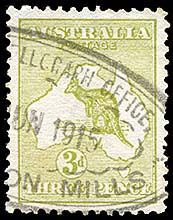 June 1915. |
|
Between 1871 and 1873, the Telegraph Office was located at the Police Station. On 5 December 1873, the Post Office and the Telegraph Offices merged. A Post Office had been established on 1 January 1870. The Albany Mail of 25 April 1883 reported that "The Council was prorogued on Thursday till the 4th July ... with regard to the Mount Barker telegraph station, as it was a pressing necessity, the Committee of Finance, under the Audit Act would be consulted, and if they agreed it will be proceeded with". No other details are known about this urgency. In October 1892, a tender was accepted from Mr. Jas. Mackie to construct the Mount Barker Post and Telegraph Office and quarters for £ 933 6s 6d. Although four rubber oval date stamps (RO2) were issued to the Mount Barker Office between 1950 and 1976, three were for POSTMASTER and the other for POST OFFICE. |
|
A Post Office was opened on 2 June 1884 and it was upgraded to a Post & Telegraph Office on 13 April 1893. In October 1892, a tender was accepted from Mr. J. G. Harwood for the North Fremantle Post and Telegraph Office and quarters for £ 1,066 6s 6d. |
|
|
|
| Personnel:
In 1894, the staff at the Fremantle Post and Telegraph Office comprised:
They were to be continued, and 3 telephone attendants would be added. |
|
| Three formats of rubber oval date stamp were issued to North Fremantle: | |
|
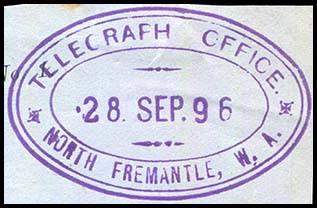 28 September 1896. |
|
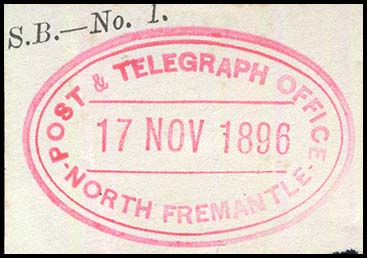 17 November 1896. |
|
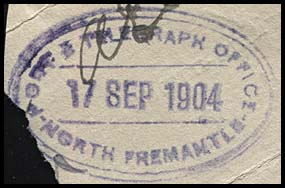 17 September 1904. |
|
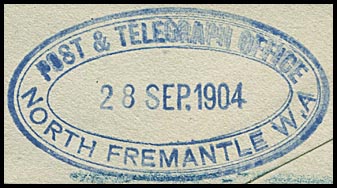 28 September 1904. |
|
The Post & Telegraph Office was opened on 17 February 1872. The station used the call signal P. The newly elected member to the Legislative Council for the seat of Murray and Williams - Captain Theodore Fawcett - said, when meeting the people after his 1886 electionFawcett held the seat until January 1889 and he died in March 1898.:
Unfortunately - for the Postmistress - Fawcett's strategy was not put in place. The West Australian of 5 June 1893 reported: "It is learnt here with regret that our worthy postmistress and telegraph operator has sent in her resignation of the latter office. She finds it impossible to attend to the sorting and despatching of letters and the transmission of telegrams at the same time. The telegraph messenger is fully occupied in delivering telegrams to passengers who arrive by the train, so can render no assistance to her. It appears all the letters for the road between Pinjarrah and Bunbury have to be sorted at Pinjarrah while the trains wait. The postal arrangements are not all that could be desired at present. No letters from Perth or Bunbury can be answered by the same mail train as they are not delivered till after the trains have left Pinjarrah. Then, again, our English mails lie in Perth from Monday till Friday, though a train comes to Pinjarrah on Wednesday. We hope the Postmaster General will see his way to improve this state of things shortly". Personnel: 1876: Mary Sutcliffe was the Post & Telegraph Mistress. |
|
|
|
|
|
Pinjarra was issued with a rubber oval TELEGRAPH OFFICE date stamp (RO7-TO):
|
|
Prior to the date stamp above, the usual postal date stamp with Pinjarrah (including the H) was used for telegraphic work:
|
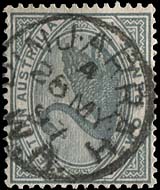 28 May 1897. |
|
A Post Office was opened at Quindalup on 19 July 1864. The Inquirer and Commercial News of 17 March 1893 noted:
The Post Office was upgraded to a Post & Telegraph Office on 4 April 1893. |
| No date stamp for the telegraph operations has been recorded. |
|
A Post & Telegraph Office was opened in South Fremantle on 1 April 1904 upon a change of name from Beaconsfield which in turn had been opened on 1 August 1894. |
|
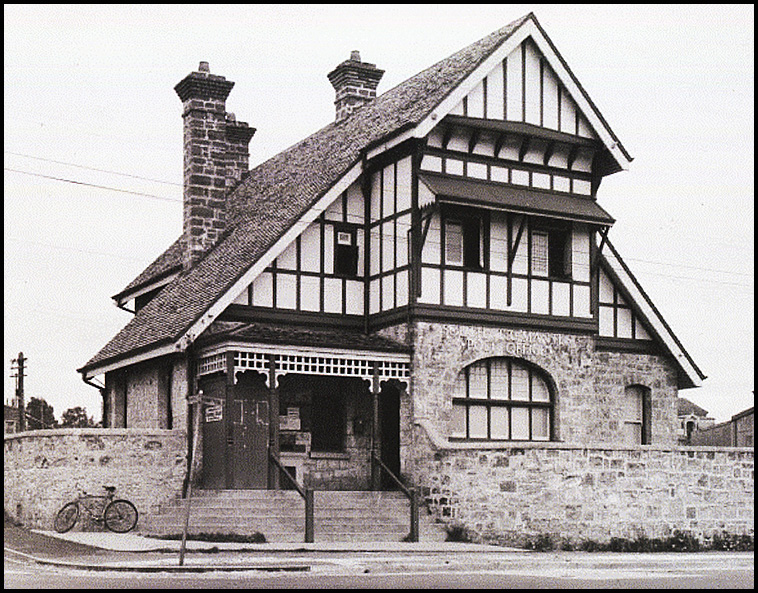 South Fremantle Post Office about 1940. |
|
| There is no record elsewhere of a date stamp being issued to this office for use with Telegraphs.
Nevertheless at least one format is now recorded. Note the inscription at top is in sans serif font with the lower inscription in serifed font. |
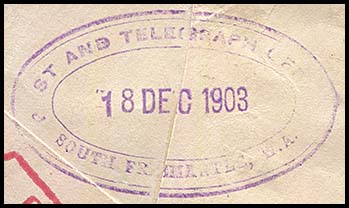 18 December 1903. |
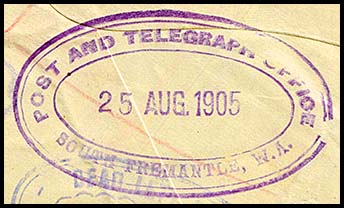 25 August 1905. The latest recorded date for this oval datestamp. |
|
In August or September 1905, this date stamp was altered for some reason by deleting the "OST AND" section leaving most of the "P" behind.
|
 TO 1905 Sept 15.jpg) 15 September 1905. On reverse side of an OHMS cover sent from the Office of Titles to South Fremantle. |
|
The Post & Telegraph Office opened on 20 September 1894. There is no record of a special date stamp for use with Telegh being issued to the Office. |
|
|
In Clare's Weekly of 18 January 1899, the statement was made: "Wanted, a Progress Committee who are not afraid to approach the Government with a view to securing a post and telegraph office, also railway siding and goods shed with competent officials in charge for the benefit of residents of Waroona; also a better representative in the House of Assembly who will look after the interests of the community, and not a favored few". Three months later, in Clare's Weekly of 8 April 1899, it was reported that " tenders have been called for the erection of a Post and Telegraph Office (at Waroona) and, I am glad to notice, that definite steps are about to be taken". The Post and Telegraph Office was opened at Waroona on 17 July 1899 on the renaming of Drakesbrook RMB (which had been established in August 1896). In the Federal Election of March 1901, the Waroona Telegraph Office was used as one of the Polling Places in the Fremantle Electorate. The Western Mail of 3 May 1902 reported a problem at the Post Office as follows: "A representative meeting of residents, with Mr. R. E. Pugh as Chairman, was held here today when Mr. A. J. Wilson proposed and Mr. Wass seconded
Two types of rubber oval Post & Telegraph Office date stamp were issued to the Waroona Office. These are distinguishable easily by size and the inclusion (or not) of the letters W.A. in the lower inscription: |
|
|
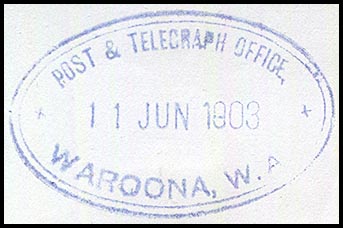 11 June 1903. |
|
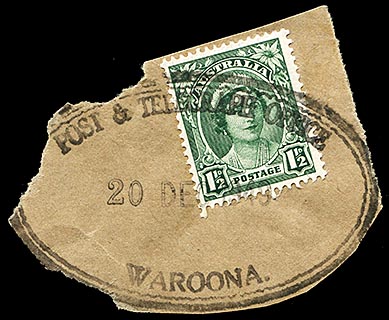 20 December 1949. |
| Yarloop.
The Post & Telegraph Office was opened on 1 June 1897. The Office was issued with at least two formats of rubber oval Post & Telegraph date stamps: |
|
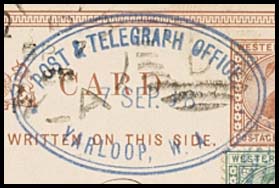 7 September 1898. Prestige Philately February 2009 Lot 427. |
|
|
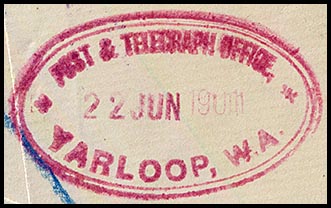 22 June 1901. |
|
|
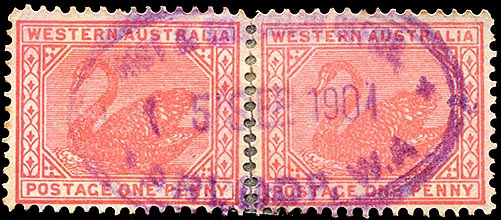 15 September 1904. |
|
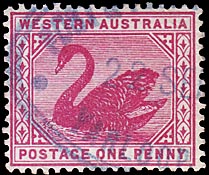 22 September (1904??). |
||
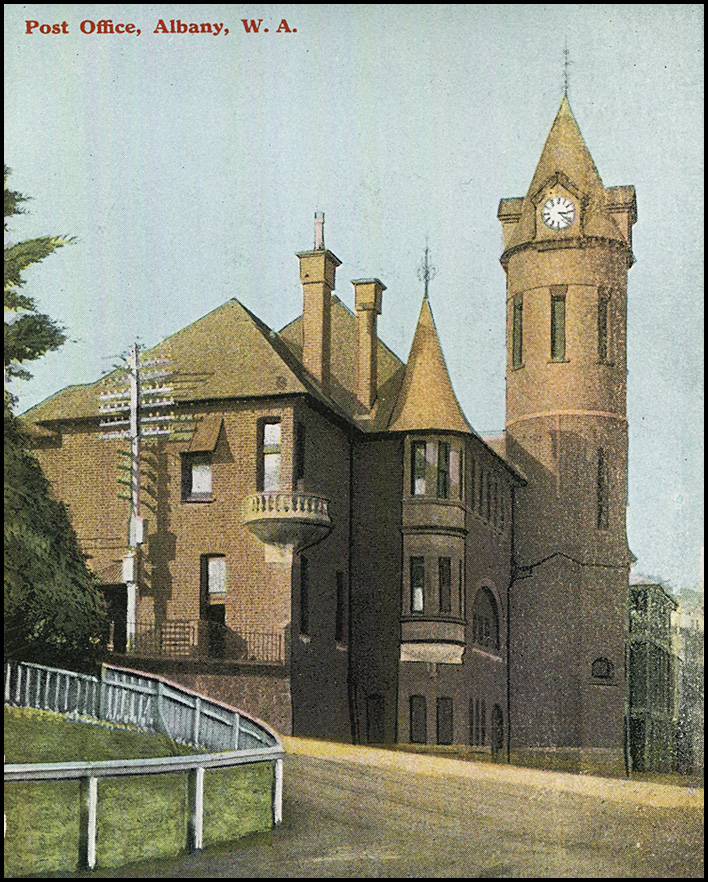
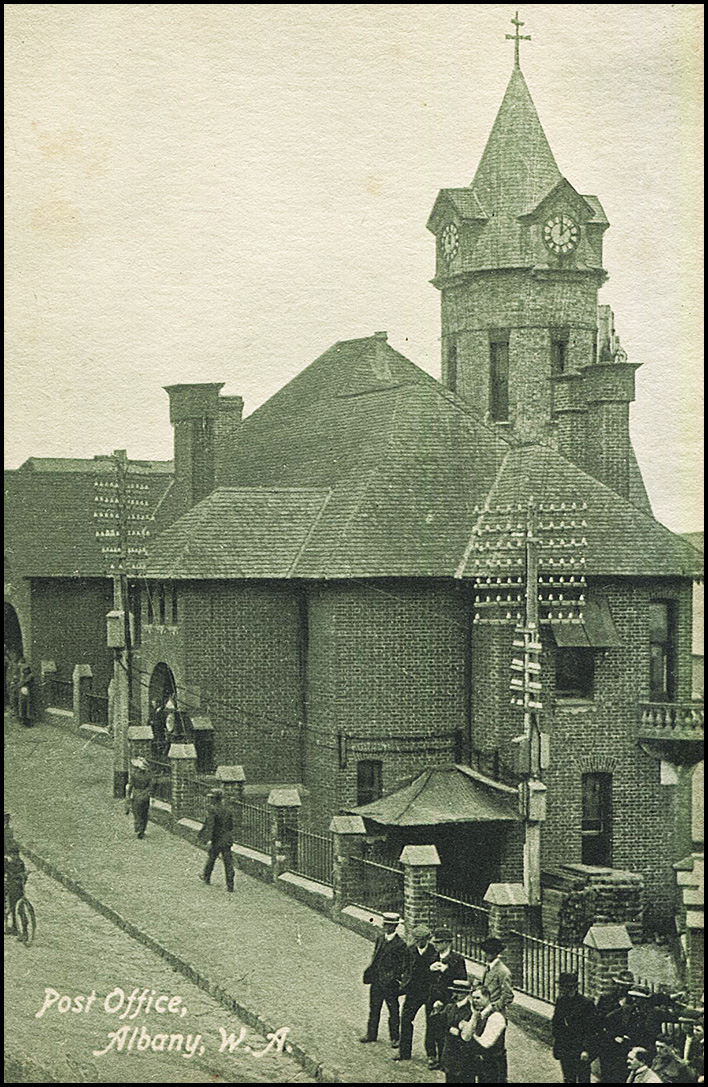
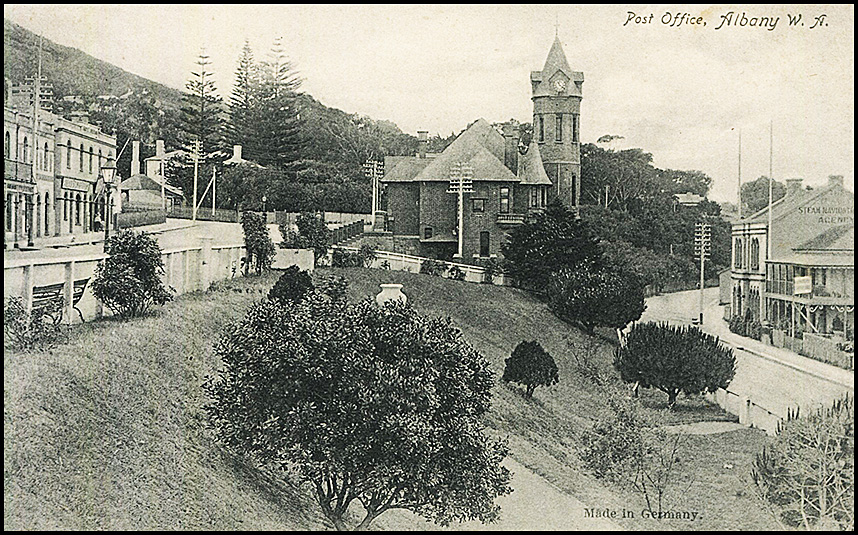
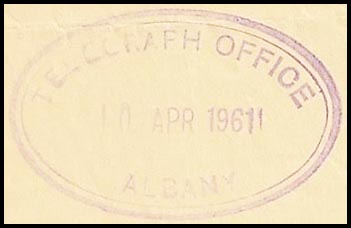
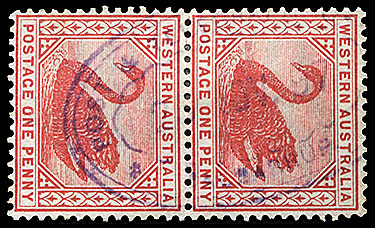
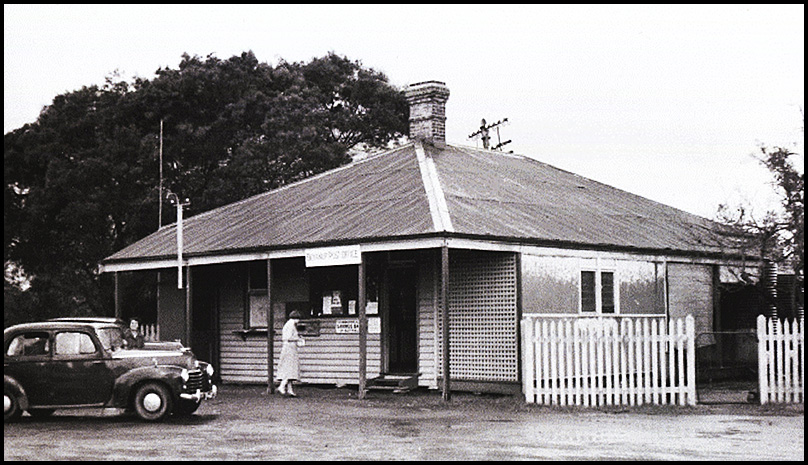
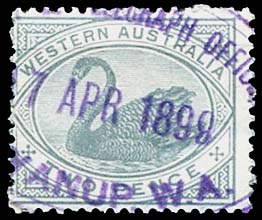
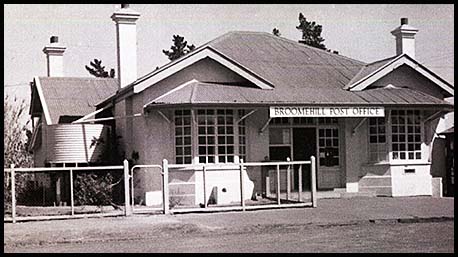
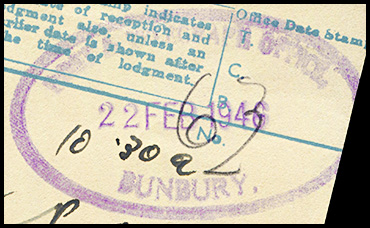

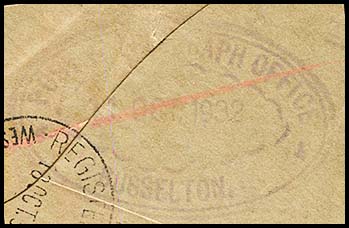
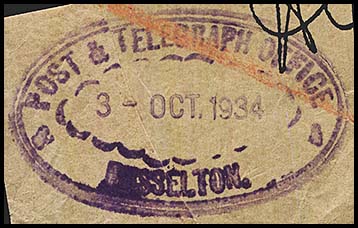
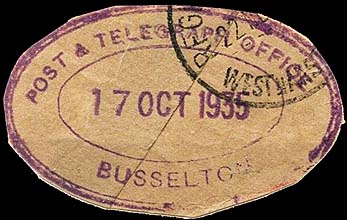
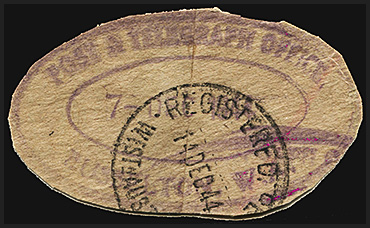
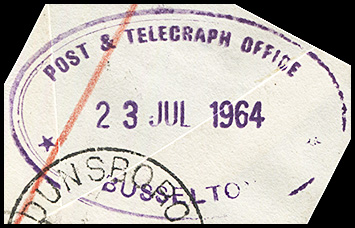
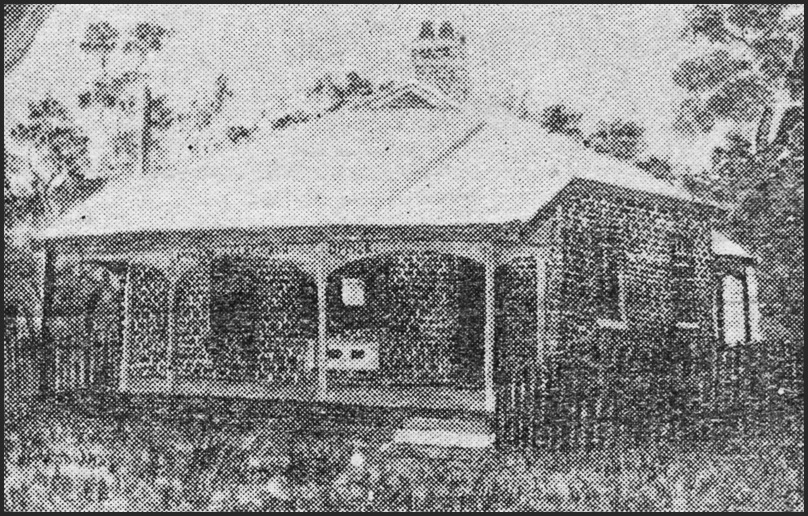
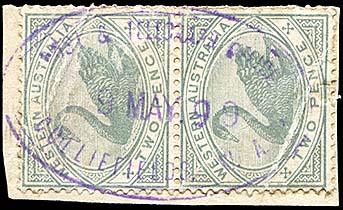
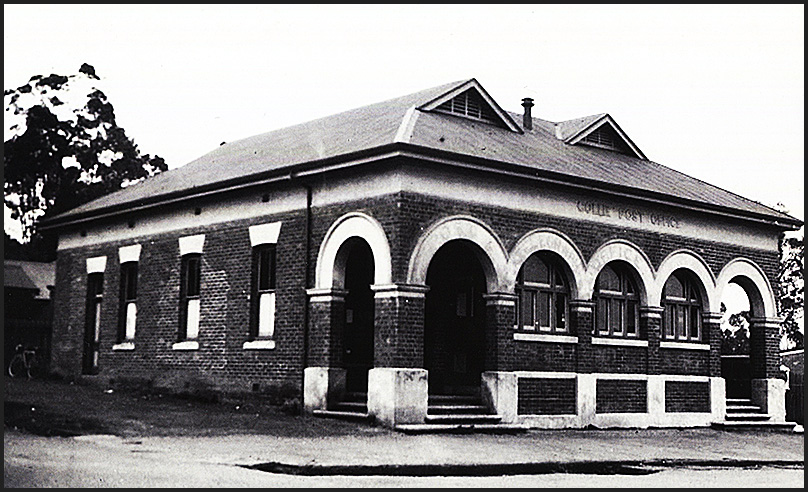
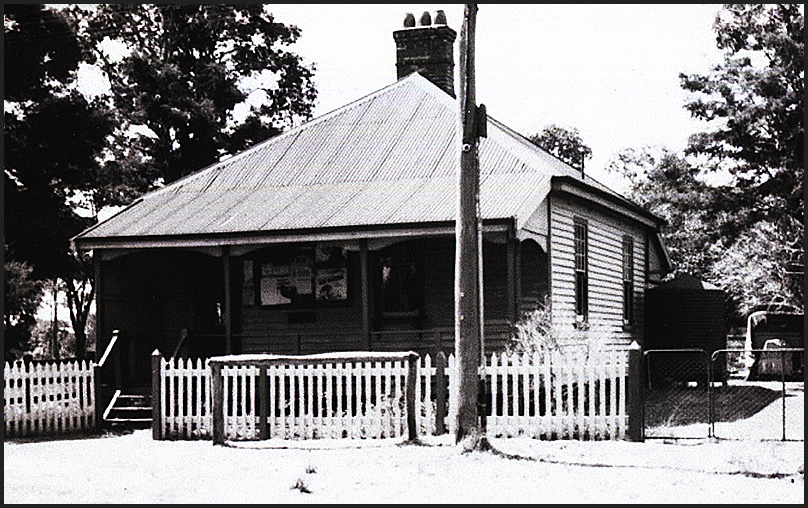
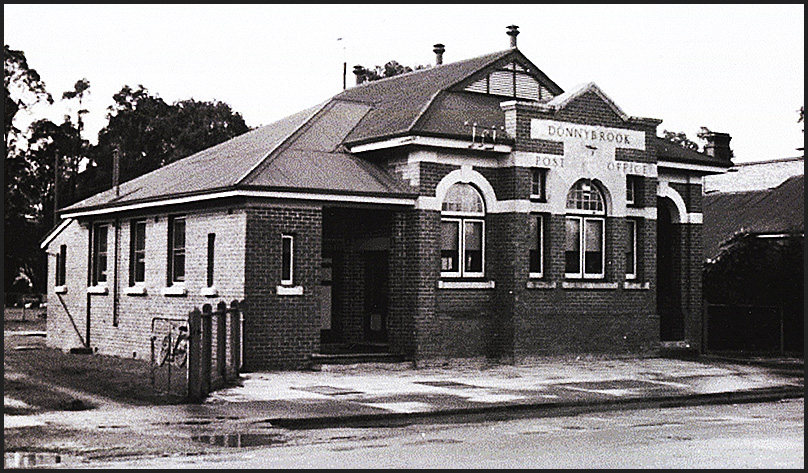
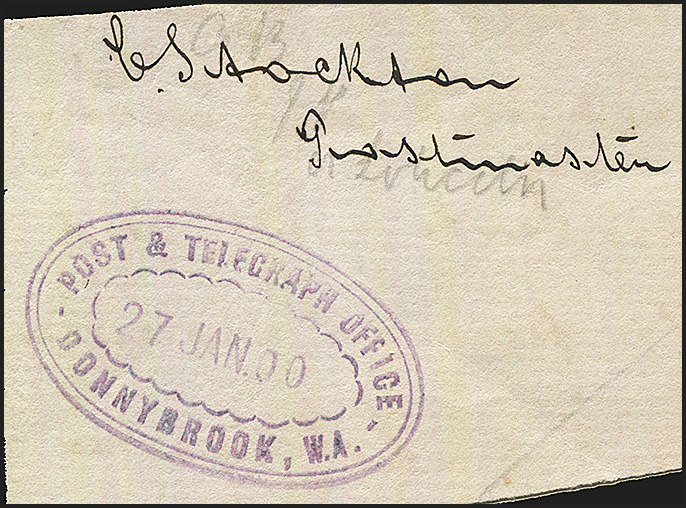
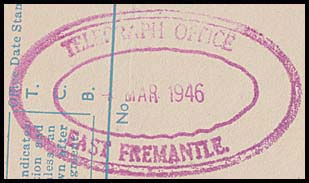
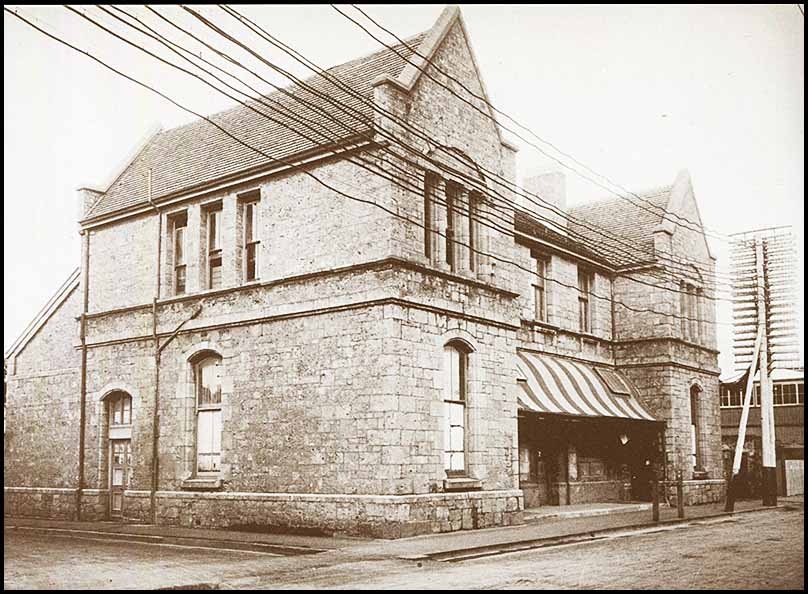
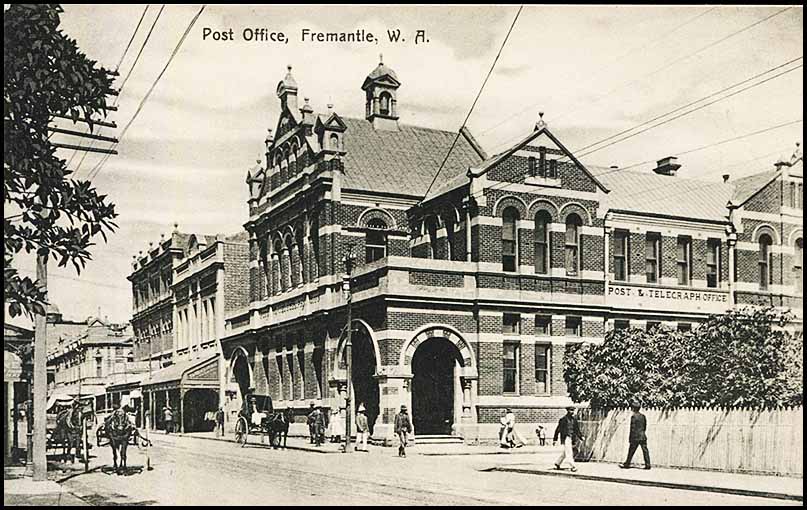
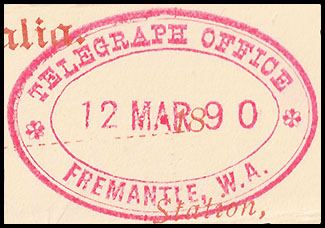
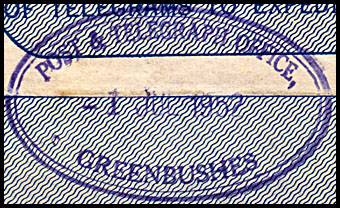

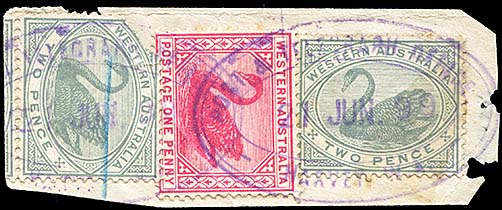
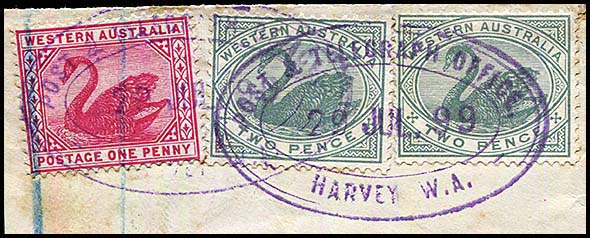
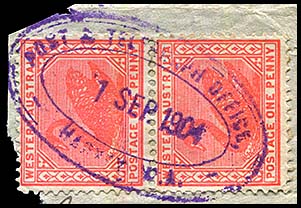

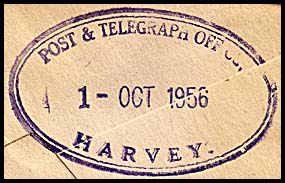
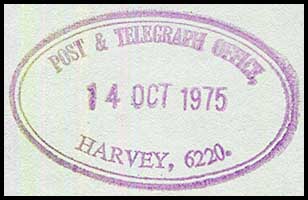
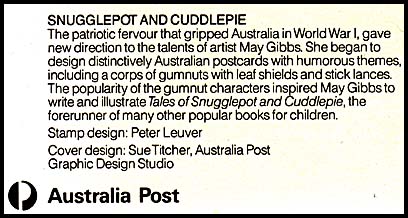
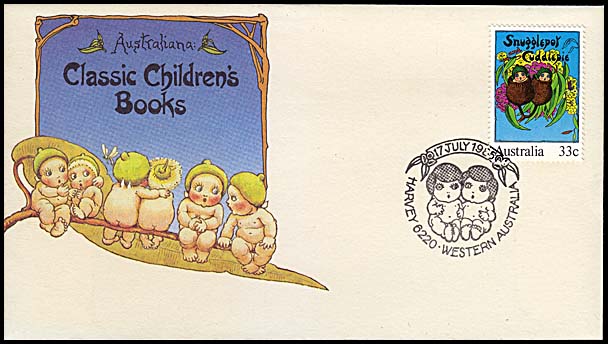
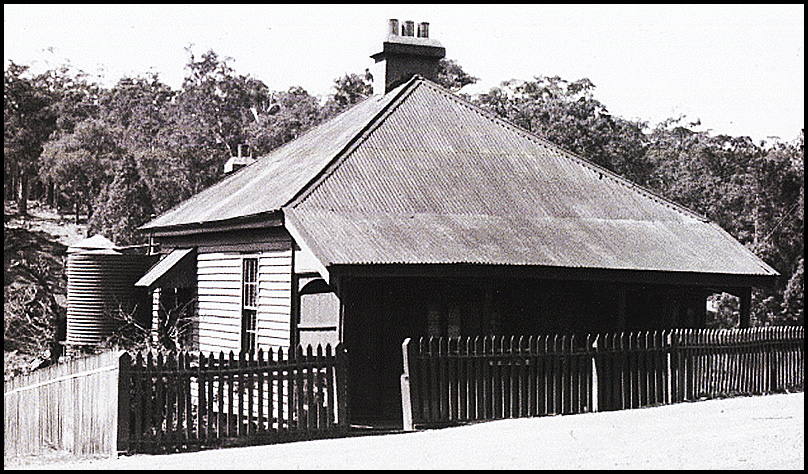 Jarrahdale Post & Telegraph Office about 1940.
Jarrahdale Post & Telegraph Office about 1940.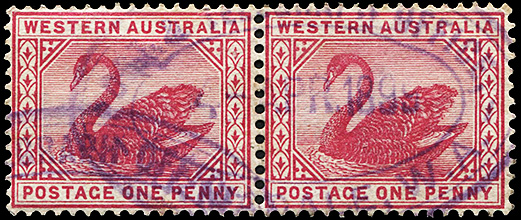
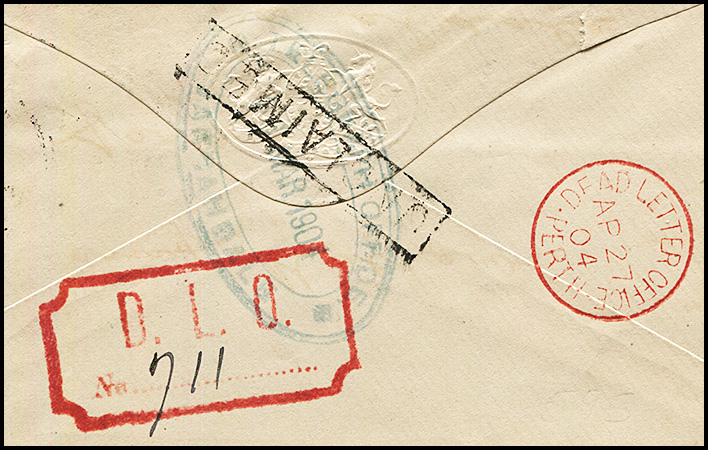
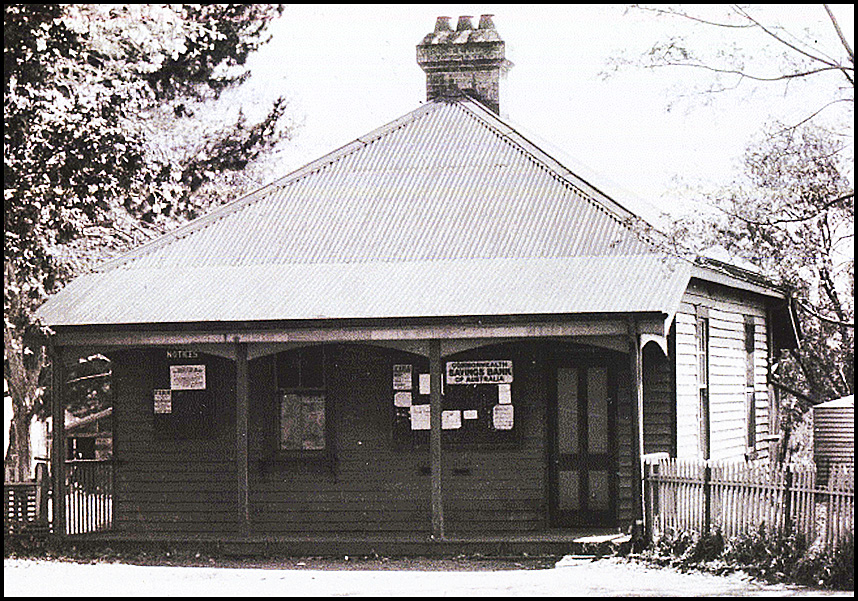 Mundijong Post & Telegraph Office about 1940.
Mundijong Post & Telegraph Office about 1940.